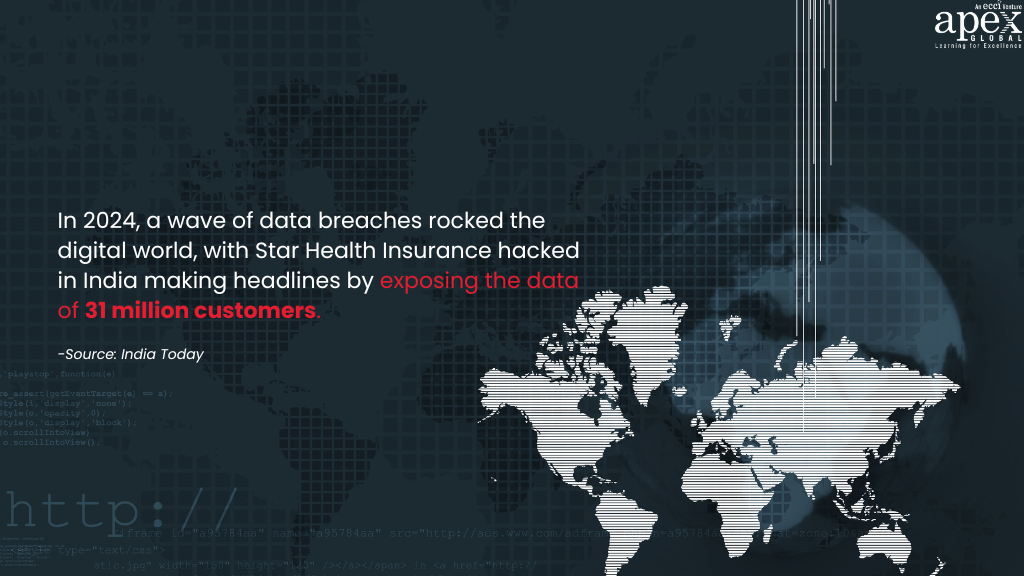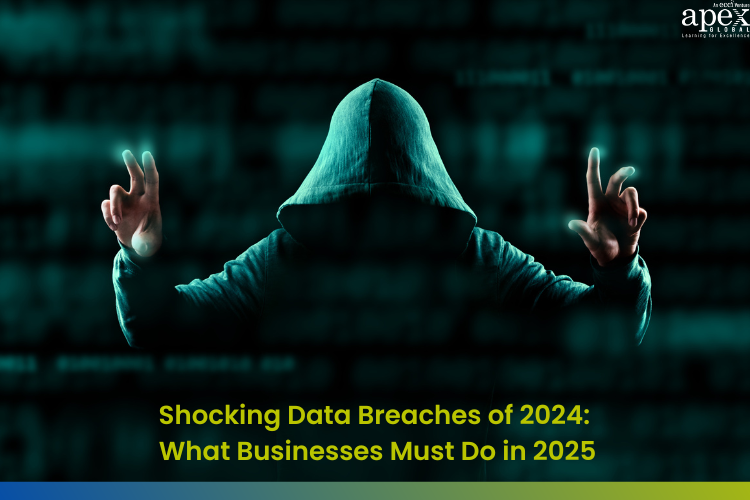In 2024, data breaches shook the digital world, impacting millions and draining businesses of billions. Cybercriminals are getting smarter, faster, and more relentless, turning the rapid rise of digital transformation into a double-edged sword. Sure, we’ve unlocked incredible convenience, but at what cost? Vulnerabilities are everywhere, lurking in the systems we trust the most. South East Asia alone saw staggering incidents, like the breach of Star Health in India, where hackers exposed data of over 31 million customers, revealing the massive scale of the threat. For businesses, it’s not just about losing money anymore, it’s about losing the trust of your customers, tarnishing your reputation, and watching your brand crumble.

The 2024 Data Breach Chronicles: Top 5 Cases and Insights
To underscore the importance of robust cybersecurity measures, let’s examine significant data breaches from 2024—their causes, impacts, and lessons.
1. Jollibee Data Breach – Philippines
The Jollibee Foods Corporation experienced a massive data breach impacting 11 million customers. This incident also affected brands like Burger King and Panda Express. Hackers gained unauthorized access to sensitive customer information due to a lack of robust database security measures.
2. Chicha San Chen Membership Database Hack – Singapore
The popular bubble tea chain, Chicha San Chen, reported a breach compromising its membership database. Customer names, contact details, and other personal information were exposed due to inadequate security controls.
3. Star Health Insurance Data Breach – India
A breach at Star Health Insurance resulted in the exposure of personal data for 31 million customers. The attackers exploited system vulnerabilities, gaining access to sensitive health records and financial details.
4. Indian Telecom Data Breach
A significant data breach in India exposed the personal data of 750 million telecom users, including names, addresses, and Aadhaar numbers. The breach highlighted the risks associated with storing large volumes of data without adequate security measures.
5. Acer Philippines – Employee Data Leak
Acer Philippines faced a breach that exposed employee data to a hacking forum. This incident resulted from poor internal security practices and insufficient monitoring mechanisms.
These cases highlight the necessity of adopting internationally recognized frameworks to mitigate risks and enhance resilience against cyber threats.

Top 10 Robust Cybersecurity Tips That Might Help You Stay Unhackable in 2025
As the digital landscape continues to evolve, so do the threats targeting individuals and organizations. Cybercriminals are employing increasingly sophisticated tactics, making robust cybersecurity practices more crucial than ever. By proactively securing your digital assets and staying ahead of potential vulnerabilities, you can safeguard sensitive data and ensure business continuity. Here are the top cybersecurity tips to help you stay protected in 2025.
1. Build a Strong Cybersecurity Framework: NIST CSF Implementation
Align your security strategy with the NIST Cybersecurity Framework 2.0 to adopt a risk-based, comprehensive approach. Regularly update security policies to address new threats, emerging technologies, and evolving compliance requirements. Leverage the Identify, Protect, Detect, Respond, and Recover functions of NIST 2.0 to ensure a proactive and dynamic cybersecurity posture.
2. Segment Networks and Use Micro-Segmentation
Limit the spread of breaches by segmenting networks and restricting access to sensitive data through well-defined zones. Use micro-segmentation to isolate critical assets and applications from less secure areas, reducing lateral movement of attackers. Employ an ISMS practitioner to monitor network segmentation for compliance.
3. Strengthen Identity and Access Management (IAM)
Implement multi-factor authentication (MFA) and biometric authentication for all access points. Enforce role-based access controls (RBAC) to grant permissions strictly on a need-to-know basis. Use NIST’s updated access control recommendations and integrate IAM measures into your ISMS to standardize best practices across the organization.
4. Cybersecurity Training for Employees
Provide mandatory training sessions to educate employees on the latest cybersecurity threats, such as phishing scams, social engineering tactics, and secure data handling practices. Incorporate specialized courses like NIST 2.0 Framework training and ISMS Practitioner programs to deepen their understanding of risk management, compliance, and best practices. Use simulated phishing attacks and interactive exercises to enhance employee awareness and improve response capabilities, fostering a security-first culture across the organization.
5. Deploy a Security Operations Center (SOC)
Establish an in-house or outsourced SOC for 24/7 monitoring, detection, and response. Equip your SOC with advanced tools like SIEM (Security Information and Event Management) and SOAR (Security Orchestration, Automation, and Response) to automate and streamline incident response.
6. Invest in Data Loss Prevention (DLP) Tools
Use DLP solutions to monitor and control data flows across the organization. Prevent unauthorized sharing of sensitive information and enforce data classification policies. Integrate DLP tools with identity and access management systems to ensure only authorized users handle sensitive data. Regularly review and update DLP policies to adapt to evolving threats and organizational changes.
7. Conduct Regular Penetration Testing
Simulate attacks on your infrastructure to identify vulnerabilities. Address weak points proactively before attackers exploit them, as recommended by NIST 2.0 Detect and Respond functions. Include penetration testing as a regular component of your ISMS’s risk assessment process.
8. Secure the Supply Chain
Vet third-party vendors and partners for their cybersecurity practices. Mandate compliance with your security standards through contractual agreements and audits.
9. Focus on Cloud Security
Partner with reputable cloud service providers with NIST and ISO standards. Employ cloud-specific security tools, such as CASB (Cloud Access Security Broker), to monitor access and enforce policies.
10. Establish a Cybersecurity Incident Response Plan
Develop a detailed playbook for managing incidents, including steps for containment, mitigation, communication, and recovery. Regularly conduct tabletop exercises to ensure readiness. Incorporate lessons learned from past incidents to continuously improve the response plan and strengthen defenses.
Conclusion

Data privacy isn’t just a regulatory checkbox, it’s the backbone of trust and success in today’s digital world. As cyber threats grow more sophisticated, corporations must proactively strengthen their defenses and ensure that sensitive data remains secure. A robust approach combines adopting proven frameworks and equipping employees with the skills to effectively manage information security. This not only protects your business but also builds confidence among customers and stakeholders.
If you’re serious about safeguarding your organization, there are two key resources to consider:
- ISMS Practitioner Course: Gain practical expertise in building and managing an Information Security Management System (ISMS) tailored to your organization’s needs with this 2-day expert-led training. This course empowers your team to mitigate risks, protect valuable data, and align with global security standards like ISO 27001.
- Cybersecurity Posture Using NIST 2.0 Framework Course: One of the most sought-after courses in the cybersecurity domain, trusted by over 10,000 professionals worldwide. Learn to proactively identify vulnerabilities, enhance defenses, and implement a structured approach to risk management using the NIST 2.0 Framework. With the growing adoption of NIST standards—used by over 50% of Fortune 500 companies—this course equips you with the in-demand skills needed to build a resilient cybersecurity posture, protect against emerging threats, and stay compliant with global industry standards.
Data Privacy Day (January 28) is a stark reminder that protecting sensitive information isn’t optional—it’s essential. To mark this important day, we’re giving you a wonderful offer to upgrade your skills-
Bring Your Buddy!
Sign up for one of our expert-led cybersecurity courses and invite a friend or colleague to join you. Use code BUDDYPROMO and get 50% off on your buddy’s fee!
Hurry, this offer is valid for a limited time only. Let’s make data privacy a priority—together.
Got questions? Email us at [email protected]
Level up your skills today and future-proof your organization—because playing it safe isn’t an option when the stakes are this high.


